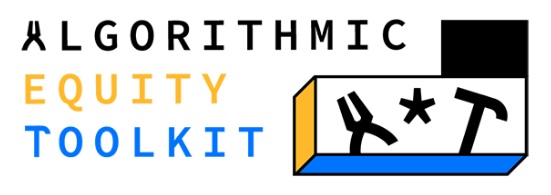By: Mike Katell
We are extremely proud to introduce the Algorithmic Equity Toolkit, planned and co-designed as a project of the Data Science for Social Good program (DSSG) at the eScience Institute in the summer of 2019. The Algorithmic Equity Toolkit, or ‘AEKit,’ is a set of resources designed to help individuals better identify government surveillance and automated decision-making technologies. These include systems that automate, aid, or replace human decision-making in a number of important contexts, including accepting or rejecting employment, housing, and public benefits applications; setting or rejecting bail; and analyzing insurance claims. The Toolkit also helps individuals to make sense of how these technologies work so that they can pose informed questions about societal impacts, effectiveness, and oversight. Our research collective, the Critical Platform Studies Group, conceived of the project in collaboration with the American Civil Liberties Union of Washington (ACLU-WA) and joined with eScience Institute Data Scientist Bernease Hermann to develop this work as a project for the DSSG summer program. We were joined by a stellar team of student fellows—Corinne Bintz, Vivian Guetler, Daniella Raz, and Aaron Tam—and supported especially by eScience Human-Centered Design Mentor Dharma Dailey, Data Scientists Jose Hernandez and Vaughn Iverson, and DSSG Program Chair Anissa Tanweer.
The team combined computer science, social science, and technology policy expertise to pursue a co-design strategy that leveraged the situated knowledge of local civil rights groups and activists working on issues of tech fairness in the Pacific Northwest. Using a participatory action research approach, the team identified key requirements and co-designed initial drafts of the toolkit, successfully involving community stakeholders in a project intended to build the capacity of community groups to identify, understand, and evaluate government technologies. Working under the tight constraint of the 10-week program, the team successfully produced several prototypes of the AEKit and conducted evaluation sessions with members of affected communities, resulting in invaluable feedback that further enhanced the project. In the months after the DSSG program, we pushed the project to an initial public release last month, leveraging especially the incredible contributions of new team members Pa Ousman Jobe, Franziska Putz, and graphic designer Micah Epstein.
The toolkit consists of four components:
- Flowchart: An identification tool to help determine whether a technology is an automated decision system, surveillance tool, both, or neither.
- System Map: A resource defining key terms used in the AEKit and mapping the relationships between the various parts of automated decision systems.
- Fill-in-the-Blank: A set of open-ended prompts that help to explore potential impacts of these technologies.
- Questionnaire: Questions about automated decision systems to ask government employees, elected officials, vendors.


